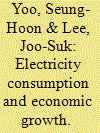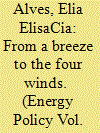|
|
|
Sort Order |
|
|
|
Items / Page
|
|
|
|
|
|
|
| Srl | Item |
| 1 |
ID:
093536


|
|
|
|
|
| Publication |
2010.
|
| Summary/Abstract |
Electricity has been the foundation of economic growth, and constitutes one of the vital infra-structural inputs in socio-economic development. The world faces a surge in demand for electricity that is driven by such powerful forces as population growth, extensive urbanization, industrialization, and the rise in the standard of living. This paper attempts to ascertain whether there is a systematic relationship between electricity consumption and economic growth. To this end, we use a large set of data that spans 88 countries during the period, 1975-2004. A statistically significant inverted-U-shaped relationship between per-capita consumption of electricity and per-capita income is detected. Nevertheless, by using a purchasing power parity that is much higher than the per-capita income of all the countries in the world, the level of per-capita income is estimated at the peak point of per-capita electricity consumption to be $61,379 in 2000 constant international dollars. Moreover, we segment the sample into Organization for Economic Cooperation and Development (OECD) countries and non-OECD countries, and separately analyze the developed and developing countries. The separate estimation shows that even though the peak income is higher than the average per-capita income, a statistically significant inverted-U-shaped relationship is found in OECD and developed countries but not in non-OECD and developing countries.
|
|
|
|
|
|
|
|
|
|
|
|
|
|
|
|
| 2 |
ID:
162952


|
|
|
|
|
| Summary/Abstract |
How do renewable energy policies (REPs) diffuse internationally? Are there differences between developed and developing countries? Which actors are diffusing these REPs? Also, what predominates when considering REP diffusion, national or international factors? The goal of this paper is to analyze the main vectors and actors that influence renewable energy policy adoption and identify differences between developed and developing countries. We access those questions by a mixed method analysis: quali and quantitatively. First, we discuss qualitatively the main external, intermediate and internal actors behind international wind energy policies diffusion. Then, we estimate a Poisson regression model using data for 194 countries, 102 of which are developing countries, from 2005 to 2015 testing the role of policy diffusion mechanisms on renewable energy policy diffusion. Among the main results, we found strong evidence of socialization and learning on international policy diffusion to developing countries, while domestic factors play a major role, especially with regard to market liberalization in developed countries. We also show some of the key actors related to REPs and we note that the causal mechanisms that lead to the adoption of REPs may differ among countries according to their level of economic development.
|
|
|
|
|
|
|
|
|
|
|
|
|
|
|
|
| 3 |
ID:
129487


|
|
|
|
|
| Publication |
2014.
|
| Summary/Abstract |
This paper is the first global investigation of the relationship between remittances and terrorism. To discern this relationship, we draw terrorism event data from the Global Terrorism Database and International Terrorism: Attributes of Terrorism Events. When a host of standard terrorism controls is employed, lagged remittances as a share of gross domestic product have a positive and significant impact on both domestic and transnational terrorist attacks. For the venue country's viewpoint, lagged remittances have a greater marginal impact on domestic than on transnational terrorism. However, when we investigate remittances to the home country of the perpetrator, lagged remittances have the greatest marginal impact on transnational terrorism. Throughout our investigation, standard terrorism controls perform according to our priors and those of the literature, lending credence to the isolation of the impact of remittances. We also account for endogeneity concerns.
|
|
|
|
|
|
|
|
|
|
|
|
|
|
|
|
| 4 |
ID:
130398


|
|
|
|
|
| Publication |
2014.
|
| Summary/Abstract |
This paper is the first global investigation of the relationship between remittances and terrorism. To discern this relationship, we draw terrorism event data from the Global Terrorism Database and International Terrorism: Attributes of Terrorism Events. When a host of standard terrorism controls is employed, lagged remittances as a share of gross domestic product have a positive and significant impact on both domestic and transnational terrorist attacks. For the venue country's viewpoint, lagged remittances have a greater marginal impact on domestic than on transnational terrorism. However, when we investigate remittances to the home country of the perpetrator, lagged remittances have the greatest marginal impact on transnational terrorism. Throughout our investigation, standard terrorism controls perform according to our priors and those of the literature, lending credence to the isolation of the impact of remittances. We also account for endogeneity concerns.
|
|
|
|
|
|
|
|
|
|
|
|
|
|
|
|
| 5 |
ID:
163049


|
|
|
|
|
| Summary/Abstract |
The study examines the determinants of rapes in India using state-level data for the time period 2001–2015. The panel model analysis indicates that there is no impact of education and economic growth, pointing towards a larger role of social and cultural factors in this context. The effect of deterrence variables (such as the number of police stations) is non-existent, possibly pointing towards the incompetency of the police force. Social attitude towards women emerged as the most robust predictor of the extent of rapes in India. We argue that the fundamental problem lies in the misogyny deeply rooted in the Indian society.
|
|
|
|
|
|
|
|
|
|
|
|
|
|
|
|
|
|
|
|
|